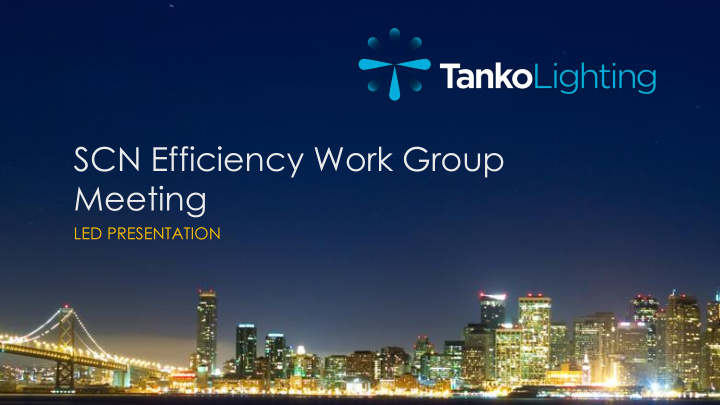



SCN Efficiency Work Group Meeting LED PRESENTATION
History Lesson Light Sources Technology CRI Incandescent 16 lm/w 2700K Incandescent 100 Mercury Vapor 35-65 lm/w 3700K (coated) Metal Halide 70 – 90 HPS/MH 75-125 lm/w 2200K/4000K LED 70 - 75 Internal reflectors for distribution High Pressure Sodium 21 High internal losses, 55%-60% gets out of the fixture Hot spotting below the fixture Max distance on center 75’ or so
Why LED’S? Light quality Dark Sky Compliant – Full cut off fixture Control over distribution patterns CRI – Color Rendering Index Public Safety Reduced Maintenance Energy Savings
What is an LED Semiconductor First made around 1962 Indicator lights Longest lasting source of light Blue LED’S for the most part used for lighting applications Phosphorus used to warm light as low as 2700K
Color Temperature
Photometrics 70W HPS
Photometrics 25W GE LED
Before
After
Wattage Translations to LED HPS Fixture Wattage Equivalent LED Fixture Wattage Range 50 – 70W 17 – 22W 100W 35 – 44W 150W 55 – 70W 200W 73 – 87W 250W 90 – 101W 400W 139W +
General Trends Cities and Towns Converting to LED Mostly on the East and West Coast Power is expensive, $.12-$.18+/ kwhr Many Projects using a Full Turn Key Model
Fixture Manufacturers GE CREE Leotek American Electric (AEL) Philips Cooper Decorative Fixtures DLC equipment & 10 yr Warranty
LED Major Points Dark Skies Light Trespass General Distribution of HID fixtures LED Efficiencies, 90-135 lm/w Ambient Temperature Requirements for Arizona Few manufacturers meet current High Temp Requirements
Maintenance HPS 18-22% regular maintenance over the course of a year LED > 1% regular maintenance per year Long Term Tree Trimming Cleaning, webs, insects, etc Day to day maintenance retracts to “real” events Power outages, Knock downs, Wire theft, Capital work
Controls What can they offer Dimming Remote Monitoring and Maintenance Wire theft/ outage detection Costs, $125-$200 per pole Long Tern Vision Smart Cities Parking Traffic Control WiFi
What now? Options for getting it done RFP Sole Source US Communities
Full Turn Key (Cafeteria Plan) Audit – GIS of entire street light system Reconcile audit data against Utility records Design Product Agnostic: DLC, 10 yr warranty Photometric Calculations/Runs Samples and Field Testing Procurement Installation – Subcontracted out Commissioning
Street Light Market Energy Service Companies (ESCO’s) Guaranteed Savings Contracts, Street Lighting already a guarantee Cover Wide Variety of Measures, Street Lighting is just one Typically Street Lighting the most lucrative, used for other weaker measures Smaller local Firms Inexperienced design and market context Single Measure ESCO/Consultants Focus Solely on Street Lighting
Typical issues Audit results Faulty wiring Tripped contactors Blown fuses Faulty photocells
Utility Rates Flat Rate per Month .$/KWHr * KWHr usage KWHr based on actual in a month or yearly average Base Charge + .$/KWHr * KWHr usage KWHr based on actual in a month or yearly average Meter Grade Controls Meter for Actual Usage Capture Savings from Dimming Share Data with the Utility
Financing Bonds Lease Purchase Financing On Bill Internal Funding Cost Benefit Analysis either way needed Cost of Project Paybacks Itemized costs per pole format Eliminates Change orders
Summary Be clear in what you want Have not done this before Get it right the first time, Don’t want to do it again Get Great Advise, Pay a Reasonable Price Connect to other Cities who have done this before There is no right or wrong way This is about what you want, It’s your experience
Questions?
Recommend
More recommend